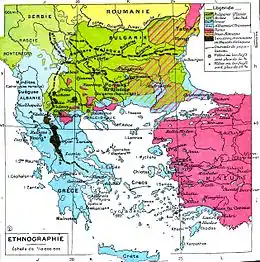Vlachs in Bulgaria
Vlachs (Bulgarian: власи/vlasi, autonymed Rumâni; Romanian: români, rumâni), are a community concentrated in the Vidin Province in the northwestern part of Bulgaria. Most of this people declare themselves vlasi (Vlachs) when asked in Bulgarian (e.g. on the census). The Vlachs in Bulgaria are not recognized as a national minority, and as an ethnic group and they don't have ethnic rights in schools or churches since the Interwar period.
| Total population | |
|---|---|
| 4,575 (2011) | |
| Regions with significant populations | |
| Vidin, Montana and Vratsa provinces | |
| Religion | |
| Bulgarian Orthodox Church | |
| Related ethnic groups | |
| Vlachs of Serbia |

_1892.JPG.webp)
The Romance-speaking community in Bulgaria (the vlasi) are roughly divided into the "White Vlachs" of Vidin and "Kutzo-Vlachs" of the Rhodopes. A part of the Vidin Vlachs is identified as Romanians, however, the Bulgarian state identifies them as Vlachs and not Romanians.[1]
History
Vlachs were identified as a separate entity during the 11th century, and their history during the Migration Period is a matter of scholarly speculations.[2] According to one theory, the Vlachs originated from romanised local Balkan tribes,[3] and their Eastern Romance language prove the survival of the latinised Thraco-Roman population in the lower Danube basin. The Vlachs came later into close contacts with sedentary Slavic-speaking communities and adopted Old Church Slavonic liturgy in the First Bulgarian Empire. The Second Bulgarian Empire established during 12th century was called also Vlach-Bulgarian kingdom. In Ottoman times, Eastern Orthodox Christians, were subsumed into the wider ethno-religious group called Rum millet. A distinct Vlach consciousness was not developed until the 19th century, and was influenced by the rise of Romanian national movement. As a result, wealthy, urbanized Vlachs were culturally hellenised during 17-18th century and bulgarised during the 19th. Some Gypsy people, which spoke Vlax Romani language, crossed the Danube during Ottoman era, because of the slavery in Vallachia and Moldova. Most of the slaves there were of Roma (Gypsy) ethnicity.[4] There were ca. 50,000 Vlachs in Bulgaria at the end of the 19th. century. At the beginning of the 20th century, a process of Romanian self-identification began in the community of Bulgarian Vlachs.[5] There is no remaining community in the Dobrogea, which Romania colonized with Vlachs when it held that region briefly between the two World wars. Vigorous assimilation occurred in the area, especially after the Second World War, and today only small groups identify themselves as Vlach or Romanian in Bulgaria.
The Vlach people in northeastern Bulgaria are referred by Romanian researchers as "Romanians".[6] The Vlachs from the Vidin Province are separated into 2 main groups: the "Dunăreni" (who live around the Danube river) and the "Pădureni" (who lived in the higher placed regions with many woods). They speak the Oltenian variety of the Romanian language. In southwestern Bulgaria lives also a very small Aromanian population, such as in the village Peshtera.[7] Part of the people, that self-declare as Vlachs, are in fact Romani people, which speak a Vlax Romani dialects.[8] In 1991, an Association of the Vlachs in Bulgaria was founded. In 2011 census 3,684 people declared themselves as Vlachs, and 891 as Romanians.
Census figures
| Year |
Vlachs | Romanians |
|---|---|---|
| 1881 | 49,063[9]a | |
| 2001 | 10,566 b | 1,088 |
| 2011 | 3,684 [10] | 891 |
^a This number shows those who identified their native language as Vlach; the 1881 census did not have a question about ethnicity.
^b The 2001 census recorded 10,566 Vlachs, most of whom are Daco-Romanian-speakers, but the figure includes some Aromanian-speakers as well.
See also
References
- Poulton 1998, p. 26.
- Schramm, Gottfried (1997). Ein Damm bricht. Die römische Donaugrenze und die Invasionen des 5-7. Jahrhunderts in Lichte der Namen und Wörter [A Dam Breaks: The Roman Danube frontier and the Invasions of the 5th-7th Centuries in the Light of Names and Words] (in German). R. Oldenbourg Verlag. ISBN 3-486-56262-2, pp. 336-337.
- Fine, John V. A (1994). The Late Medieval Balkans: A Critical Survey from the Late Twelfth Century to the Ottoman Conquest. The University of Michigan Press. ISBN 0-472-08260-4, p. 9.
- Sam Beck, "The Origins of Gypsy Slavery in Romania", in Dialectical Anthropology, Volume 14, Number 1 / March, 1989, Springer, p. 53-61.
- The Wallachian Problem in Bulgaria between the Two World Wars: Political Factors and Aspects, Author: Blagovest Nyagulov, Journal: Bulgarian ethnology, 1995, Issue No: 5, Page Range: 52-75, Language: Bulgarian.
- Boldur Alexandru, Istoria Basarabiei, Editura Frunza, Bucuresti, 1990, p 95
- Aromanians
- The Bulgarian Gypsies – Searching their Place in the Society, Elena Marušiakova et Veselin Popov, Balkanology Magazine, Vol. IV, № 2, 2000.
- General results of the population census of 1 January 1881, Statistics of the Principality of Bulgaria, p.11 (in Bulgarian and French)
- "Census Bulgaria 2011". Archived from the original on 2015-12-19. Retrieved 2013-03-05.
Sources
- Anna Krŭsteva (1998). Communities and Identities in Bulgaria. Longo. ISBN 978-88-8063-210-8.
- Tom Winnifrith (1987). The Vlachs: the history of a Balkan people. Duckworth. ISBN 978-0-7156-2135-6.
- Hugh Poulton (1998). Minorities in Southeast Europe: Inclusion and Exclusion. Minority Rights Group International. ISBN 978-1-897693-42-1.
- Gheorghe Zbuchea, Cezar Dobre, "Românii timoceni", Bucharest, 2005 ISBN 973-86782-2-6
External links
- History of the Romanians living on the South of the Danube (Romanian/Bulgarian textbook for Romanians from Bulgaria)
in Romanian
- Românii din Bulgaria
- 35 de sate de români de "mâna a doua"
- Romana, limba de circulaţie internaţională
- Limba română moare pe malul bulgăresc
- "Oltenii" din Bulgaria
- Interviu cu Ivo Gheorghiev, preşedintele Uniunii Etnicilor Români din Bulgaria
- Coloniştii români timoceni din Cadrilater
- Articol despre mănăstirea Bacikovo
- Zilele folclorului românesc în Bulgaria
- Etnicii românii din Bulgaria cer sprijinul Consiliului Europei
